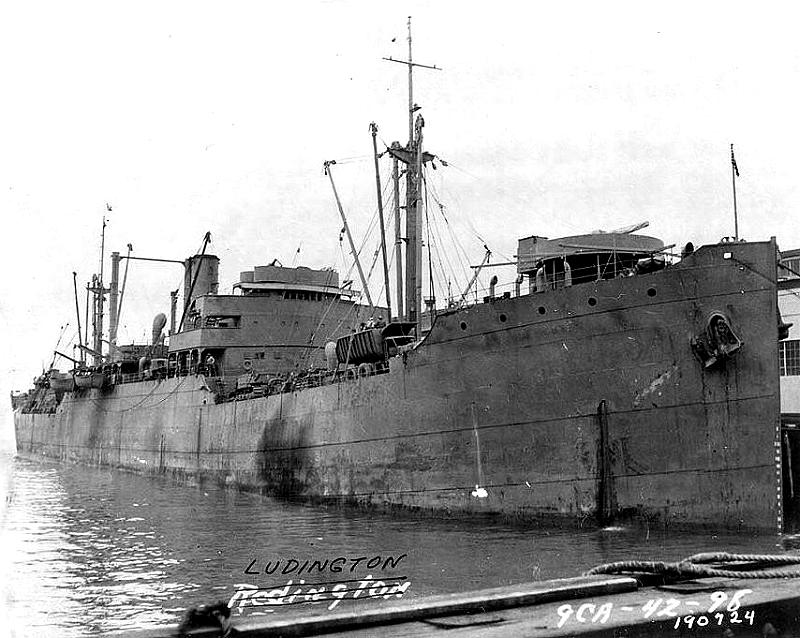

|
|
USAT Ludington first found in USS Helena CL-50 War Diary for 1 August 1942,
No FY assigned. This ship was the last of 11 large freighters built by the Pennsylvania Shipbuilding Co.
Back in 1935 the Army and Navy had agreed that the Army would operate its own ships except where
The Navy soon decided that the nine Army cargo ships on this list were unsuitable for operations in hostile
Below Photo No. SC-190724 on 8 January 1942 at Fort Mason, San Francisco.

Design: Cargo, 1920
Displacement (tons): 8,266 gross, 13,750 dwt
Dimensions (feet): 455.0' oa, 439.5' pp x 60.2' x 28.5' load
Original Armament: 2-4"/50 (1942: actual)
Later armaments: --
Complement: 94
Speed (kts.): 11.5
Propulsion (HP): 3,400
Machinery: Turbine, 1 screw.
(later taken over by the Pusey & Jones Co.) at Gloucester City, N.J. during World War I. Ordered by
commercial shipping firms, all were requisitioned by the Shipping Board in August 1917. All but the
first were named after famous American patriots. Their design was numbered 1135 by the Shipping
Board after World War I. The Army took over JAMES OTIS in 1930 or 1931 and renamed
her LUDINGTON.
naval opposition was expected, in which case the ships would be Navy manned. However, experience
in the first part of World War II indicated that naval opposition by the enemy, in the form of submarines,
could be encountered anywhere. In April 1941 the CNO proposed to the Chief of Staff of the Army that
a board review the issue. The Board recommended on 28 Apr 41 that the Army "surrender operation of
its transport service for the term of the present emergency" following procedures that it enumerated, the
first of which was that the Navy would commission the Army transports with Navy crews as soon as possible.
(The Army used the term "transports" for all ships in the Army Transport Service, including cargo ships and
other types.) On 14 May 41 the Auxiliary Vessels Board recommended the implementation of this plan,
which then covered 26 Army ships, and on 22 May 41 the Secretary of War approved the transfer of the
ships, noting that jurisdiction over each ship was to pass at the time it was manned by the Navy. On 5 Jun 41
the Secretary of the Navy approved names for the 26 ships, all but three of which (AP 21-22 and AK-39)
retained their Army names. The hull numbers AP 20-36 (less 23), AK 32-40, and APL-1
(for the barracks ship in Newfoundland) were soon assigned to them.
waters because of their age (all dated from World War I) and lost interest in manning them. On 11 Jun 41
the CNO informed major Navy commands that the commitment to man the nine cargo ships in August
could not be met and that would be held in abeyance until the Bureau of Navigation could furnish Navy crews.
The Navy manned, took over and commissioned AP 20-29 and 31-33 before the end of July but personnel
shortages then greatly slowed down the process. In December 1941 the President suspended the obligation
for the Navy to man Army ships. The Navy directive for manning AK 32-40 as well as two other low-interest
vessels, AP-36 and APL-1, was definitively cancelled on 30 Mar 42 and their hull numbers were officially
listed as "not used." AK-37 received 2-4"/50 guns on 17 Jan 42 from the Mare Island Navy Yard.